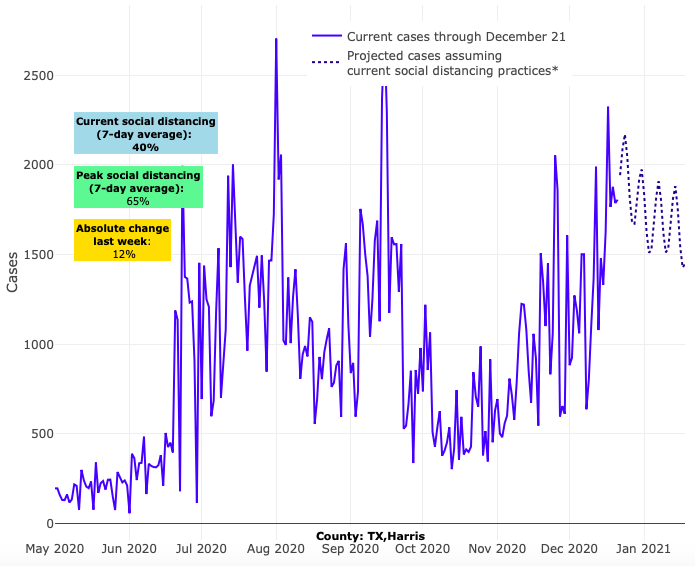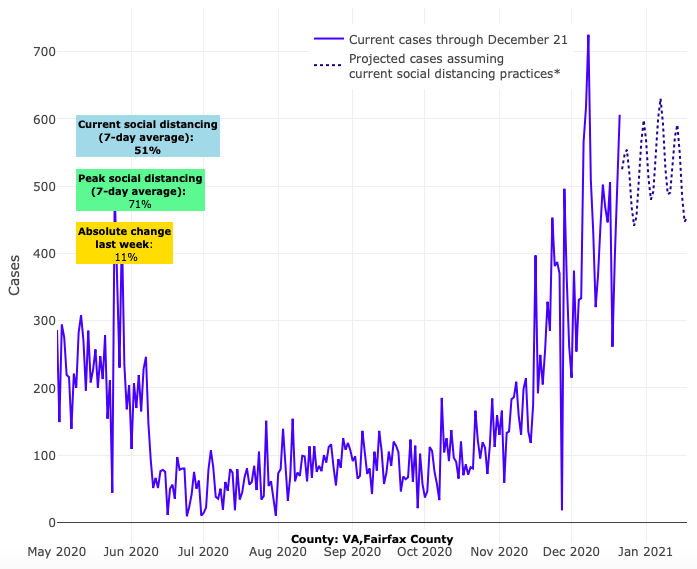COVID-19 Outlook: Striking a Delicate Balance as We Enter the Holidays
Below are the main findings from our COVID-Lab forecasting model update this week:
- Reproduction numbers are declining to below 1 in many areas across the upper Midwest, permitting a substantial decline in daily case incidence. However, in metropolitan areas of Indiana, Ohio, Missouri, Kentucky, Missouri, Oklahoma and West Virginia, reproduction numbers are hovering at or just above 1, suggesting potential opportunity for further case growth if social gatherings increase during the upcoming holidays.
- In the Northeast, Massachusetts and New York continue to experience increases in test positivity. Projections for Boston suggest the area is reaching its peak for the fall surge, while the rate of growth in the New York City boroughs has slowed slightly this week. Nonetheless, reproduction numbers in the boroughs remain above 1, signaling the need to remain committed to mitigation strategies during the holidays to help avoid potential growth in case incidence.
- In California, Los Angeles is projected to reach near or above 20,000 cases daily in the coming weeks. Projections in nearby Orange County show cases could double over the last three weeks of December. Further north, San Francisco and Sacramento are also projected to have continued growth, although some Bay Area counties may be nearing a peak in cases this week.
- Despite having a current crisis in magnitude that is similar to areas of Southern California, Nevada and Arizona experienced some declining test positivity this week, a welcome sign for areas with significant hospital strain. This change, along with our projections, suggest that many counties may be nearing the peak of a winter wave in which more ventilators were used, and more patients required ICU care than in the summer wave. Maricopa County, however, may see continued case growth beyond other regions in the state.
- Increased risk of case growth is now expanding across more locations in Texas. Projections continue to show case incidence growth in the Dallas area, with Austin, Midland, San Antonio, McAllen and Houston projected to follow in the coming weeks. In Houston (Harris County), we are forecasting cases could double over the remainder of the holiday season.
- Locations throughout the Southeast continue to accelerate in viral transmission through the month of December. Of particular concern are the major metropolitan areas of Tennessee, Georgia and North Carolina where our models project case incidence will double in the next four weeks.
- Florida continues to grow week to week in case incidence, hospitalizations and deaths, with hospitals in the state reaching 25% COVID occupancy this week. Across the state, cases are projected to double this month in Jacksonville (Duval County), Tampa Bay (Hillsborough County) and Orlando (Orange County). Miami’s case incidence is passing 600 cases per 100,000 residents and will likely reach a winter peak that is similar in magnitude to the summer surge they experienced.
PROGRESS AND CHALLENGES AS WE LOOK AHEAD TO THE HOLIDAYS
Last week our team noted that many areas of the country had reached a tenuous equilibrium, experiencing stable, albeit high, numbers of cases and hospitalizations. This week we see new COVID-related hospitalizations holding steady across certain regions like the Upper Midwest and Mountain states, a welcome relief for communities with a dearth of additional capacity in acute care hospitals and exhaustion among their health care workforce.
Other areas around the Ohio Valley and across the Appalachian Mountains are also seeing stabilized incidence rates, but have not yet seen the declines in hospitalizations or ICU use of their neighbors to the north and west. This supports the notion that hospitalization numbers will persist in a region well after they reach peak case incidence. In the Northeast, projections for Boston suggest the area is reaching its peak for the fall surge, while the rate of growth in the New York City boroughs has slowed slightly this week. Nonetheless, reproduction numbers in the boroughs remain above 1, with continued growth in cases within surrounding counties (including into Northern New Jersey), signaling the potential for further growth in incidence if gatherings increase during the holidays.
We suspect the equilibrium achieved in many but not all counties in the Northeast, Midwest, and Mountain states is, in part, the result of a critical number of individuals infected to date (thus reducing people who may still be susceptible to infection in high-risk circles). Additionally, these areas are likely benefiting from an increasing commitment to reduce the size and frequency of gatherings. However, we worry that the equilibrium of caseloads in these areas is particularly fragile as we look to the coming holiday weeks. Any disregard for recommended limits on gathering sizes or reduced commitment to hygiene could cause these areas to again face increasing incidence rates.
This past week, London was a stark example of how relaxing restrictions can overcome any stability in viral transmission. London’s attempt at a rapid reopening before the Christmas holidays was quickly followed by significant increases in cases necessitating a full shutdown. A narrative is emerging that this rapid reversal of fortune was the result of a new, more transmissible strain. However, we must recognize that both steady and abrupt erosions in social distancing and mask use are proven causes of increased transmission and are likely at the center of the situation in London.
The cautious optimism we have from counties with stable and even declining incidence rates is offset by continued acceleration of viral transmission and hospitalizations across other regions in California, the South and into Mid-Atlantic states. For several weeks, California has garnered significant attention, in particular in the Los Angeles basin area, for their rapid increase in cases and dwindling availability of ICU beds. This week our models again project an increase in cases for many Southern California counties. The growth of cases is also expanding across more locations in Texas. Projections continue to show increases in case incidence in the Dallas area, with Austin, Midland, San Antonio, McAllen and Houston projected to follow in the coming weeks. In Houston (Harris County), we are forecasting cases could double over the remainder of the holiday season.

Above are the projections for Harris County in Texas.
In the Southeast, Tennessee, Mississippi, Alabama and Georgia are all seeing COVID patients overwhelm ICU occupancy with more than 50% of ICU patients in many locations occupying hospital beds due to severe COVID illness. As the incidence rates and hospitalization numbers continue to climb across these states, we fear the potential for holiday week gatherings could further accelerate community transmission. In Florida, the ICU occupancy rate of COVID patients has crept north of 25% and Miami is nearing a peak in transmission similar to the summer. This increase should serve as a warning to the state that without mitigation they could soon find themselves dealing with ICU rates as high as their southern state counterparts.
In the mid-Atlantic, the DC metro area, much like the Carolinas, continues to grow in ICU occupancy and has not yet fully reached peak transmission. The high rates of COVID infection that persist through counties in Delaware, Maryland, and Virginia reveal that these regions are possibly a few weeks behind the Midwest experience, and thus may be at greater risk for a post-holiday surge than other regions of the country.

Above are the projections for Fairfax County in Virginia.
HOW CAN LESSONS LEARNED FROM THANKSGIVING INFORM CHRISTMAS AND NEW YEAR'S?
Whether you live in an area with declining, stable or increasing case numbers, we all must recognize that Christmas gatherings have the potential to create local, post-holiday surges. We saw this in the weeks following Thanksgiving and there is no reason to expect anything different after Christmas. While the winter holidays are traditionally a time of multigenerational gathering, we must recognize the significant risk that such activities pose this year. That risk exists not just for Christmas Eve and Christmas but also extends to New Year’s Eve and New Year’s Day.
We are particularly concerned about New Year’s Eve when individuals may be tempted to attend large indoor gatherings of friends where the excitement of the moment could lead to poor mask wearing. These gatherings foster opportunity for spread of COVID-19 and the potential for the virus to be carried back to household family contacts. We witnessed a similar dynamic during Halloween weekend, which was followed by increasing COVID-19 cases. If we are to see an accelerated phase of community transmission beginning after New Year’s, we expect we would see signals of this by the weekend of January 8th.
For those who choose to gather with extended family during this holiday season, we hope they have prepared appropriately for these gatherings, including quarantining voluntarily in the time leading up to the gathering and limiting interactions while traveling to the gathering location. Further, individuals choosing to gather must remember that masking and distancing in the presence of anyone not part of their immediate family will protect them, their loved ones and the community at large.
As you consider your holiday plans and activities in the coming weeks, we would emphasize that in this winter peak of the pandemic, the risk is not confined to elderly patients in long-term care facilities. It is sobering to recall that the majority of COVID hospitalizations this fall have been among individuals younger than 65 years of age, and a quarter are among individuals younger than 45 years of age. More than a quarter of deaths among residents in California, exceeding 5,000 in total, have been among residents under 65 years of age; only a third have been from residents of long-term care facilities (nationally, long-term care facility deaths comprise 38% of all deaths). In the week following Thanksgiving, cases among working-aged adults in North Carolina surged by 62% in one week and hospitalizations for this age group accounted for half of all of hospitalizations on November 22.
FINDING COMPROMISE FOR WINTER SPORTS
With viral transmission surging in the last few weeks across Pennsylvania, our state and local governments, and many others across the country, have adopted restrictions that prohibit team competition for winter sports over the holiday season. While not universal throughout the country, the decision to delay team competition for youth winter sports is a wise one given the phase of resurgence we are in and how much it can improve community safety as we reach the end of winter just a couple of months in front of us.
This week, our team—alongside colleagues in Children’s Hospital of Philadelphia’s Sports Medicine and Performance Center, Division of Infectious Diseases, and Center for Injury Research and Prevention—released updated guidance around winter youth sports amid the COVID-19 pandemic. Although the concepts are not new, there is an increased emphasis on masking during indoor sports and a suggestion that teams can still focus on training while competition may be suspended. We also discuss the growing role of assurance testing for athletes, acknowledging that transmission around youth sports, even if not occurring on the field itself, has contributed to growing community transmission this fall. We have learned how to make these environments safer, and would encourage all to recommit to safety protocols that can ensure safety and increase the potential that future sports seasons can move forward without additional quarantine measures or cancellation of games.
LOOKING TO THE YEAR AHEAD
As we enter the upcoming holidays, we wish families a safe and healthy week, and offer our optimism that the year ahead will be a better one. As much as pandemic fatigue has gripped our country, and as much as we crave the ability to gather and see our family and friends, we hope that many will remain resolute to keep their bubbles small this holiday season, looking ahead to better days and new family memories that are not too far away.
From our PolicyLab family to yours, happy holidays and best wishes for a safe and better new year!

